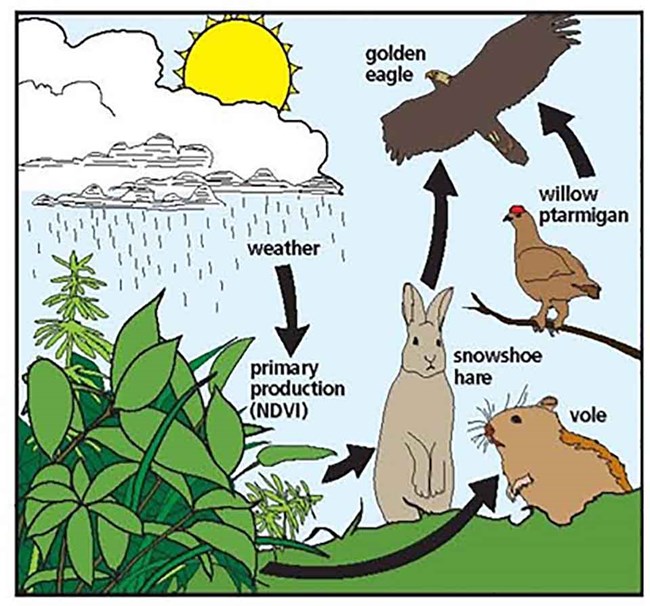Last updated: April 9, 2018
Article
Bottom-Up Ecosystem Drivers

Two recent publications highlight bottom-up drivers of the predator-prey system in Denali. We found that while Golden Eagle reproductive success generally tracks prey abundance (hares and ptarmigan), it does so in a lagged fashion. This result provides further evidence that bottom-up (primary production) rather than top down (predation) forces are the dominant drivers in this system. The companion to this paper, detailing the effects of weather and primary productivity on cyclic vole and hare population dynamics in Denali, was also recently published. Together these two papers help us to better understand predator-prey dynamics and variation in the Denali ecosystem. We expect this work will also be very useful in framing future research in other parks in the region.
Bottom‐up processes drive reproductive success in an apex predator
Abstract
One of the central goals of the field of population ecology is to identify the drivers of population dynamics, particularly in the context of predator–prey relationships. Understanding the relative role of top‐down versus bottom‐up drivers is of particular interest in understanding ecosystem dynamics. Our goal was to explore predator–prey relationships in a boreal ecosystem in interior Alaska through the use of multispecies long‐term monitoring data. We used 29 years of field data and a dynamic multistate site occupancy modeling approach to explore the trophic relationships between an apex predator, the golden eagle, and cyclic populations of the two primary prey species available to eagles early in the breeding season, snowshoe hare and willow ptarmigan. We found that golden eagle reproductive success was reliant on prey numbers, but also responded prior to changes in the phase of the snowshoe hare population cycle and failed to respond to variation in hare cycle amplitude. There was no lagged response to ptarmigan populations, and ptarmigan populations recovered quickly from the low phase. Together, these results suggested that eagle reproduction is largely driven by bottom‐up processes, with little evidence of top‐down control of either ptarmigan or hare populations. Although the relationship between golden eagle reproductive success and prey abundance had been previously established, here we established prey populations are likely driving eagle dynamics through bottom‐up processes. The key to this insight was our focus on golden eagle reproductive parameters rather than overall abundance. Although our inference is limited to the golden eagle–hare–ptarmigan relationships we studied, our results suggest caution in interpreting predator–prey abundance patterns among other species as strong evidence for top‐down control.
Schmidt, J. H., C. L. McIntyre, C. A. Roland, M. C. MacCluskie, and M. J. Flamme. 2018.Bottom-up processes drive reproductive success in an apex predator. Ecology and Evolution 2018:1-9.
Weather-driven change in primary productivity explains variation in the amplitude of two herbivore population cycles in a boreal system
Abstract
Vertebrate populations throughout the circumpolar north often exhibit cyclic dynamics, and predation is generally considered to be a primary driver of these cycles in a variety of herbivore species. However, weather and climate play a role in entraining cycles over broad landscapes and may alter cyclic dynamics, although the mechanism by which these processes operate is uncertain. Experimental and observational work has suggested that weather influences primary productivity over multi-year time periods, suggesting a pathway through which weather and climate may influence cyclic herbivore dynamics. Using long-term monitoring data, we investigated the relationships among multi-year weather conditions, measures of primary productivity, and the abundance of two cyclic herbivore species: snowshoe hare and northern red-backed vole. We found that precipitation (rain and snow) and growing season temperatures were strongly associated with variation in primary productivity over multi-year time horizons. In turn, fourfold variation in the amplitude of both the hare and vole cycles observed in our study area corresponded to long-term changes in primary productivity. The congruence of our results for these two species suggests a general mechanism by which weather and climate might influence cyclic herbivore population dynamics. Our findings also suggested that the association between climate warming and the disappearance of cycles might be initiated by changes in primary productivity. This work provides an explanation for observed influences of weather and climate on primary productivity and population cycles and will help our collective understanding of how future climate warming may influence these ecological phenomena in the future.
Schmidt, J. H., E. A. Rexstad, C. A. Roland, C. L. McIntyre, M. C. MacCluskie, and M. J. Flamme. 2017. Weather-driven change in primary productivity explains variation in the amplitude of two herbivore population cycles in a boreal system. Oecologia.
